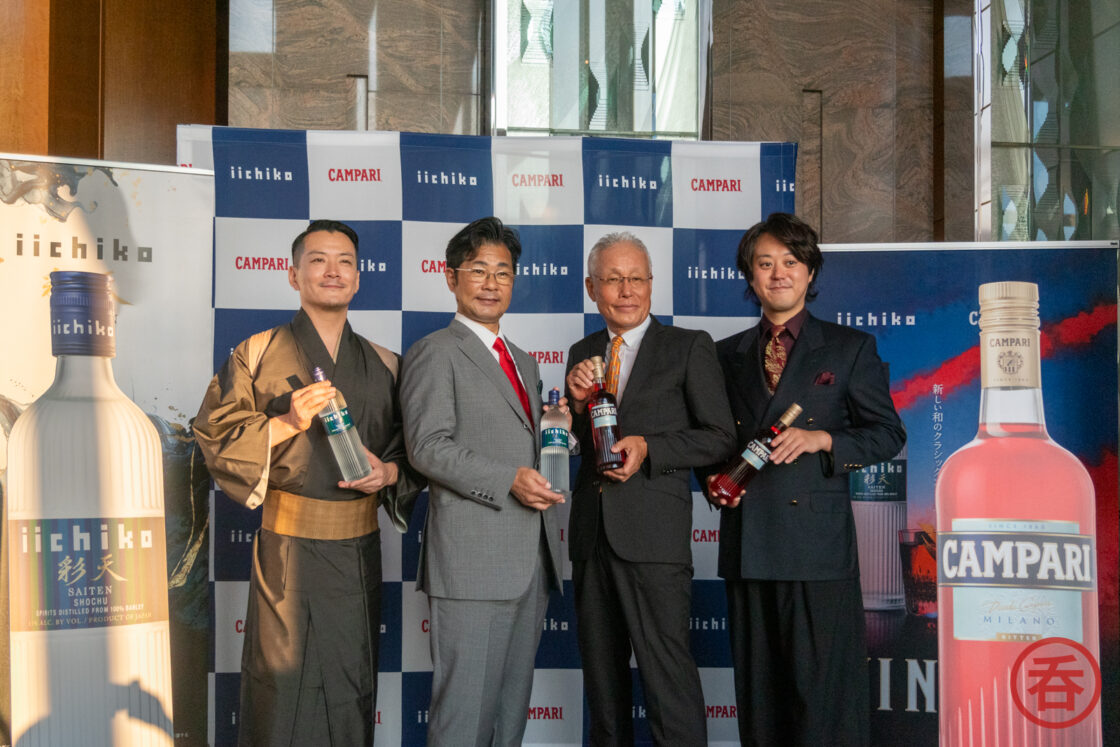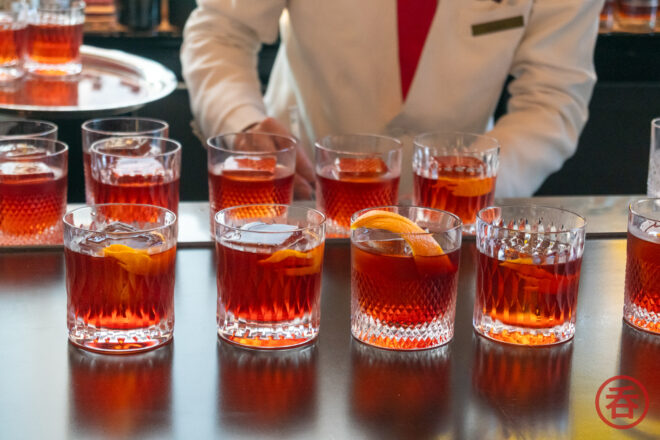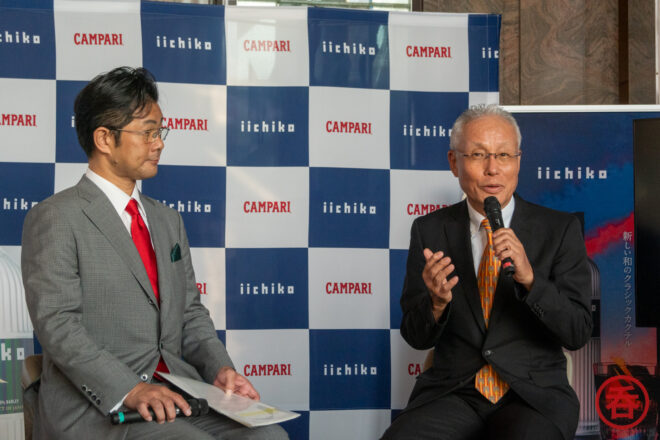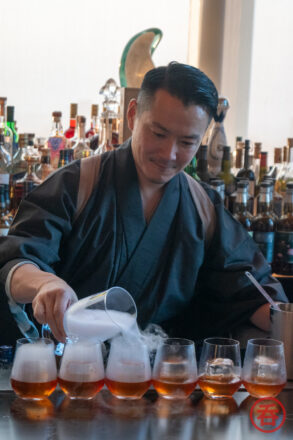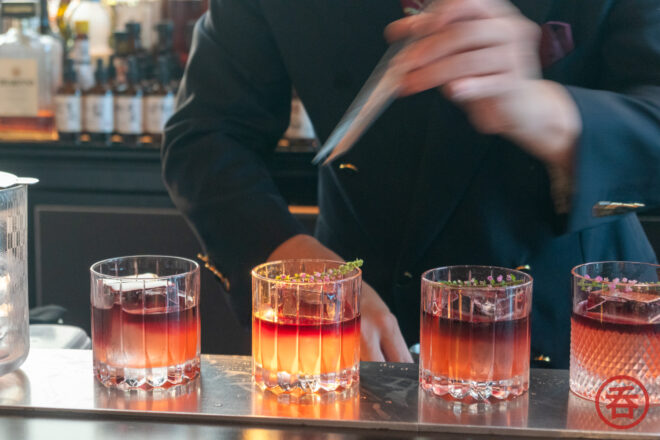Hot on the heels of the official launch of iichiko Saiten in Japan, Campari Japan and iichiko maker Sanwa Shurui have teamed up to push a “Koji Negroni” into your hand during this year’s upcoming Negroni Week, running from September 22 to 28. We once again visited the Ritz-Carlton Tokyo in Roppongi for a Koji and Negroni-fueled press event.
The Koji Negroni
A classical Negroni consists of 1:1:1 of gin, sweet vermouth, and Campari. It’s been around for over 100 years by now, making it a bar staple worldwide.
The Koji Negroni substitutes the gin for iichiko Saiten and changes the ratio to 6:5:5 (30ml iichiko Saiten, 25ml Campari, 25ml sweet vermouth if you hate math). Simple.
I found the drink to have an excellent, velvety mouthfeel compared to the classic Negroni. That’s not by accident either: iichiko Saiten gets its rich umami from koji. Thus the name of the drink. You still get that blend of bitterness and sweetness from the Campari and vermouth, of course.
You may think to yourself: I have a bottle of shochu here at home. All shochu is made with koji. Can I make one now?
I won’t tell on you if you try, but the clencher here is that iichiko Saiten is 43% abv. If you swap in a regular barley shochu (probably 25% abv), chances are the Campari and vermouth will overpower it. As you might remember from the launch, iichiko Saiten is specifically positioned to serve as a base for cocktails. And bases have to be bases.
To be clear: the Koji Negroni is absolutely not a rice-washed “Sushi Negroni,” a drink which rose to popularity a couple years ago when someone discovered that the starch from uncooked sushi rice mellows the classic a bit.
Sanwa Shurui and Campari Japan
We already know about Sanwa Shurui’s ambitions for iichiko Saiten. Why would a global brand like Campari care, though? Campari Japan’s CEO was on hand to explain that he had actually wanted to collaborate with a shochu brand since five years ago. Campari, for their part, wants to see shochu succeed globally, and Campari intends to be more successful in Japan. On a personal note, he believes collaborations like this one can help spread Japanese culture globally. Given the emphasis both companies have put into international expansion, I expect the Koji Negroni to find its way outside of Japan soon.
Negroni Week
Launched back in 2013 by Imbibe and Campari, Negroni Week is a worldwide event that saw participation from more than 13,000 bars in 90 countries across the globe in 2024. It’s not just about drinking Negronis though: in 2024, over $630,000 was raised across 79 countries in support of Slow Food, a “a global movement of local communities and activists across more than 160 countries seeking to change the world through food and beverage.”
Want to have a Negroni? Find a participating bar near you. Chances are there’s at least one; Japan alone has more than 400.
If you specifically want to try a Koji Negroni, though, I’ll point you to the official Japan Negroni Week website that has a list of bars in Japan offering the drink.
Collab with SG Group’s Shingo Gokan and Campari Brand Ambassador Naoto Ogawa
If you want to try your hand at making a Koji Negroni yourself, you might as well learn from the masters. Here’s the two of them making one–Gokan-san is supposed to be “cool Japan” and Ogawa-san is “Italian passion”:
Given this was a press event, both were on hand to offer their own riffs of the Koji Negroni. Yes, the drink already has riffs…
Shingo Gokan’s “Bincho Negroni”
Bincho (備長) basically means “char-grilled,” and Gokan-san uses the name because his cocktail is meant to conjure images of yakitori. Alongisde iichiko Saiten and Campari, it has passion fruit and char-grilled schmaltz: not a typical cocktail ingredient. He uses a smoker to present it as well, further building the yakitori theme.
Naoto Ogawa’s “The Beyond”
Ogawa-san told a story about how when he was in Italy and ordered a Negroni, he noticed that they aren’t mixed as thoroughly as they are in most of the world. Following that trend, flavors of “The Beyond” come in waves: first you have Lambrusco, then you get the iichiko Saiten with Campari, and end with peach & shiso vermouth.






Hi there! I created and run nomunication.jp. I’ve lived in Tokyo since 2008, and I am a certified Shochu Kikisake-shi/Shochu Sommelier (焼酎唎酒師), Cocktail Professor (カクテル検定1級), and I hold Whisky Kentei Levels 3 and JW (ウイスキー検定3級・JW級). I also sit on the Executive Committees for the Tokyo Whisky & Spirits Competition and Japanese Whisky Day. Click here for more details about me and this site. Kampai!

